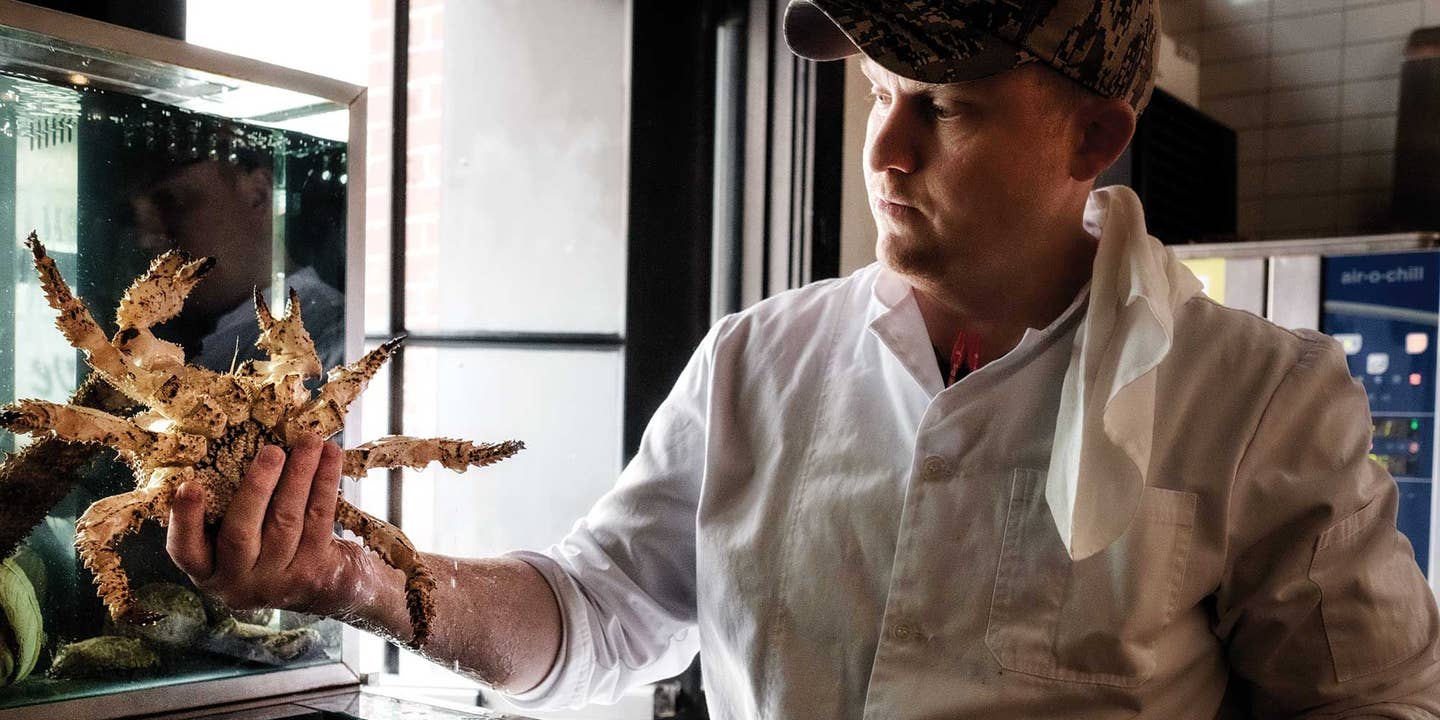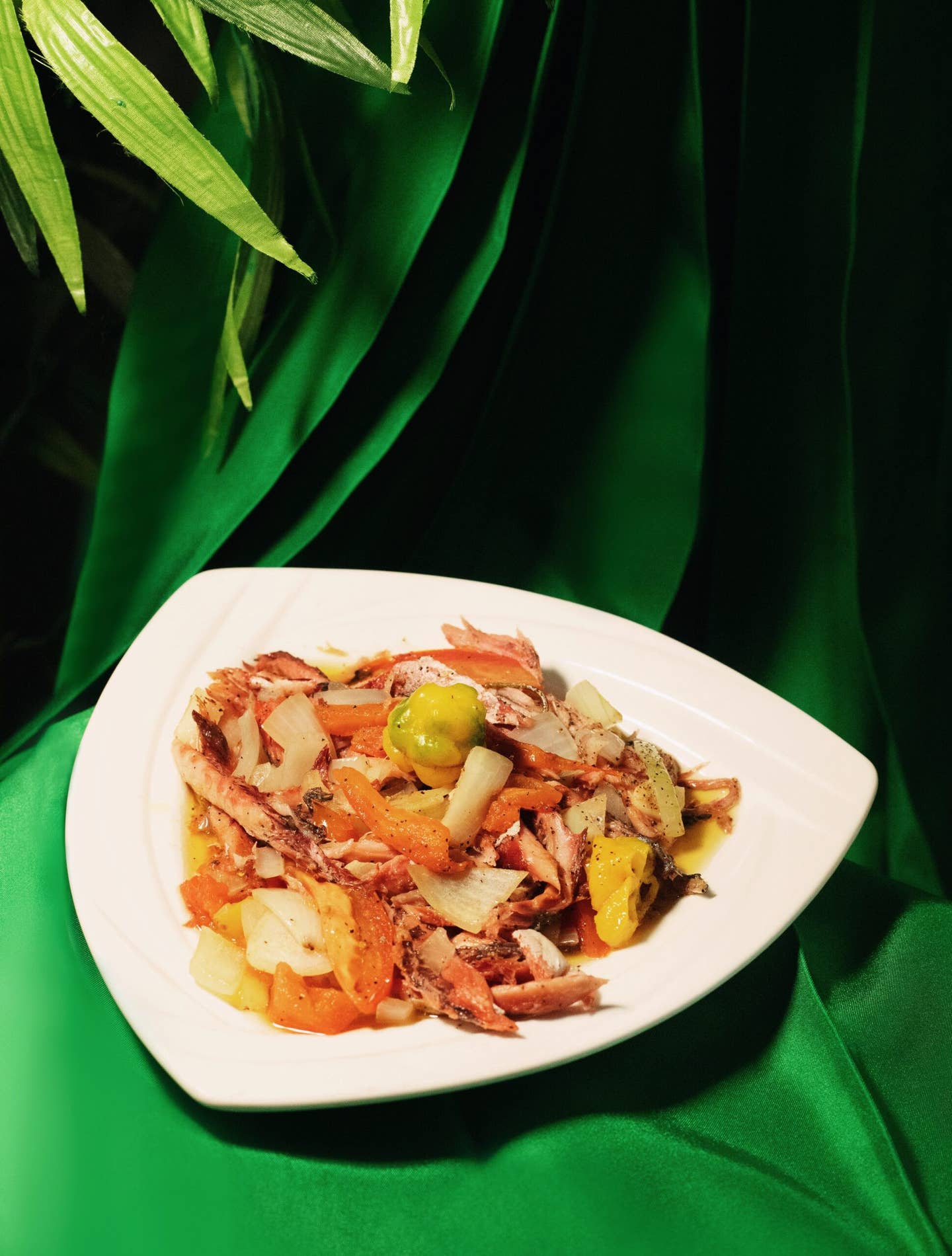
Joshua Skenes Has a Fleet of Fishermen and an Abalone Farmer on Retainer
This chef of the tasting-menu temple Saison goes the distance to get the goods
The fluke is kelp-brown and speckled, shiny, still wet from the tank. It strains against the cutting board, thrusting up its head and tail to convulse into a taut, furious U. The spiny rays of its fins ripple, as if trying to find traction against currents of air—an impossible escape. Its splayed eyes look desperate.
We’re at the seafood butchery station, under a tall, frosted-glass window that looks out onto a South of Market alleyway in San Francisco, flooding light on the fluke slowly expiring on its wooden board. With a downward lunge of his blue-gloved hands, Joshua Skenes drives the tip of a chef’s knife into a spot behind the head that experience has mapped. His features compress with the effort. “You go through the brain,” he says, “to paralyze the nerves.” Skenes steadies the fish under one hand and severs the caudal fin with the other, then snakes a thin wire into a cavity in the flesh. “This prevents rigor mortis,” he tells me. “You’re bleeding the fish, but in a way where the heart’s still pumping all the shit out. It’s pretty straightforward.” Nothing about it looks that way.
Skenes is the chef and owner of Saison, a restaurant with three Michelin stars and a 10-course tasting menu that is one of the most expensive in the country ($395 a pop, $546 per person if you opt for wine), where a dozen cooks are prepping for tonight's service. A dinner there can check off the boxes on a roster of tasting-menu tropes (lobster, caviar, Krug champagne). But what makes Saison different is that Skenes has what nobody else does: the frigid waters of California's central coast, including the rivers, estuaries, deltas, and tidal pools, which practically run through his veins like saltwater through a submersible pump in a reef aquarium; his own abalone farmer, sea harvester, and fisherman—just for the restaurant; and a series of tanks into which these farmers directly haul their live goods. "I would say I'm very connected to the ocean," he says.
Twice I notice him throw his arms out to stretch, like his chef’s jacket is strangling him. He seems confined indoors, which makes sense for a chef who is as passionate about fishing and hunting as he is cooking. Saison’s menu rotates between fin fish such as diamond turbot and black cod, abalone, and so many lobes of uni packed onto Saison’s signature toast course that they come to the table looking like a single fat, orange ruffle. On any given night there might be weird and bumpy or otherwise amorphous creatures such as sea cucumbers, moon jellyfish, and, the homeliest of all, box crabs—things that few chefs ever see, much less work to understand. Even the meat course on the menu one night—a grilled, aged T-bone from a pronghorn antelope, served next to a plump barbecued quail—felt like a temporary diversion from seafood rather than a red-meat anchor.
Skenes says his commitment to serving a range of oceanic creatures and having them delivered live to the kitchen is an ethos, a set of principles. “With every single piece of sea life, not just fish but all of the crustaceans and bivalves and shellfish and seaweeds—you can keep that pristine flavor up only until a certain point.” His certainty about those points makes a meal at Saison feel like a set of orchestrated movements of the sea.
He plans to apply them this summer to Angler, a new restaurant with two locations (one in San Francisco, the other LA) dedicated to seafood. They’ll be more casual than Saison—and definitely less pricey—but built on a similar schematic as the one he has worked out over the past eight years: cooking in a 32-foot fireplace and holding the catch from local suppliers in about 20 feet of live tanks. Seasonally there might be cured Pacific rockfish with Meyer lemon, spot prawns grilled over a bed of seaweeds, or steamed California king crab served with butter churned from the milk of Skenes’ own cows (he has a farm north of the restaurant, in Sonoma County). Other dishes will reflect Skenes’ passion for hunting, including Hopi cornbread with boar fat and elk steak. “It’s a very simple restaurant,” the chef says, “based on celebration and pleasure and fun and very simple food.”
Spend an hour in Saison’s kitchen one afternoon, as a dozen cooks focused on prep for the evening menu dart around you, and the intricate work of cooking “simple” dishes is clear. But the true heart of the restaurant isn’t in the broad, open kitchen : It’s at one end of the loftlike dining room, in a narrow workspace called the lab. That’s where the bulk of the ocean harvest—fish bones and skin, as well as humbler creatures such as herring and sardines—is distilled, smoked, infused, and fermented into sauces, essences, and salts, the backbone of Skenes’ cooking. So much of what happens here touches fire, at some carefully controlled degree of intensity. It’s the engine of transformation. Saison began in 2009 as a Sunday night pop-up in the Mission District, in a little kitchen next to a patio with a big open fireplace. It was there, experimenting with cooking over flame, that Skenes says the world split open for him. He preserved tomatoes and cooked vegetables slowly, suspended high above a gentle fire, absorbing low, nudging heat. “Some things were accidental, some were intentional—all these little methods started to happen. Since then we’ve been developing this pantry of our own methodology. It opens up the world.” One essential technique that fuels Saison’s lab is “fire in the sky,” which sounds apocalyptic but actually calls for patience: slowly drying ingredients on metal racks high above the fire in the kitchen hearth. Today, there are shiny, dark-ringed slices of red abalone undergoing fire in the sky. Once dried, they’ll cure for about a week in jars, and end up with the deep, funk-tinged earthy smell of white truffles.
The chefs make salt from seawater pumped from the Pacific beyond the mouth of Monterey Bay, evaporating it in troughs over burning almond wood. Over days it takes on a subtle smokiness, an oceanic freshness with the warmth of fire. The resulting salt is used to cure Saison’s caviar, harvested from sturgeon raised near Sacramento. Saison sauce—a pale-whiskey-colored seasoning, similar to fish sauce—is made from drying and smoking the bones of flatfish over fire, then brewed four quarts at a time. “We use it at least as much, maybe more, than we use salt,” says Jonathan Dewolf, Saison’s culinary director. “It’s an elixir.”
Skenes mists some from a small plastic spray bottle onto rippled glasslike cubes of moon jellyfish he’s just taken from a tank. On its own, the jelly tastes like clean seawater. With Saison sauce, it gains dimension, like peering into clear ocean water and sensing the depths in the darkness below.
The light bleaches the sands of Del Monte Beach where it sweeps south to meet Monterey’s municipal wharf, curving like some mammoth bone left long ago to blanch in the sun. Here, a little more than a hundred miles south of Saison, on California’s central coast, I meet Art Seavey in front of the Monterey Abalone Company. Seavey, 60, is lean and professorial, with silver-white hair that looks sculpted by onshore breezes. He and Trevor Fay own this small aquaculture and marine harvesting company, which supplies Skenes with farmed red abalone, wild moon jellyfish, sea vegetables, and occasional buckets of ocean water (for poaching, mostly), pumped from the depths off Point Pinos.
It’s this relationship with the ocean itself that animates Saison, feeding its connection to the coast in ways both visible and hidden. Most chefs rely on wholesalers or seafood brokers to tell them what’s available. Skenes talks directly with aquaculturists—marine farmers—and harvesters of wild sea life. There’s a feeling of active maintenance of the sea here, the same way farmers engaged in sustainable practice talk as much about cultivating healthy soil as they do the sweetness of this year’s crop of Seascape strawberries.
Seavey is a marine biologist who turned to aquaculture to prove it could be sustainable: a way to feed the planet’s growing taste for seafood in a way that doesn’t stress the oceans. Skenes credits Fay with changing his thinking about seafood (Saison used to source from Tokyo’s Tsukiji market), expanding his palette of edible sea life, and anchoring the kitchen to California’s coastal waters.
I follow Seavey through a hatch in the pier, down a ladder to a dark world of wooden platforms that descend into luminous green water. The walkways are in sections, hinged, folded up when the humans leave to keep sea lions from hoisting themselves up to loll. This is the place where abalone grow, in dishwasher-size cages tethered by ropes to the pier, suspended in the bay.
California's commercial abalone fishery shuttered in 1997 due to persistent population decline. Sport harvesting was allowed on the coast north of San Francisco until last year, when state officials noticed a shortage of kelp. It stayed closed this year, and probably won't open in 2019. "It's tough," Seavey says. "There's a tremendous amount of labor, especially the way we farm." Abalone are slow-growing and can have a longer life span than we do. "They can be over 100 years old when they're 10 inches or greater," Seavey says. But, he says, "We feel like we're involved with producing sustainable food, locally produced food, that's an iconic food for California."
Later that night, at Saison, Dewolf serves me one of the abalone that spent four years feeding on kelp under the Monterey pier. A flat bowl contains a huge abalone shell, its iridescent mother-of-pearl lining flashing with reflected light. Inside the shell, under a loose thatch of braised seaweed, are three thick slices of abalone, colored a beautiful shade of caramel from the grill. There’s a bit of clarified seaweed butter on top, and on the table, a small bowl of brown butter sauce containing the abalone’s liver.
I’m only five courses into the menu and already a little buzzed on champagne, sake, and grüner veltliner, poured by waiters so stealthy that I note only peripherally how wine keeps seeping back into my glass. Phil Collins is singing to take a look at him now (Skenes told me he makes a point of blasting “shitty ’80s music” to get diners dropping four figures on dinner to loosen up). The abalone’s texture is firm enough so it actually feels good to send my teeth through it, yet smooth as burrata. The flavor reads like an ambered reflection of the sea, saline purity with a faint overlay of smoke and richness, as if the whole structure of Skenes’ restaurant—the cooks, the custom Molteni range, and the tanks, the hearth, and the narrow little lab upstairs—exist solely as some elaborate machine to reveal to me the pure, raw taste of the sea.
Keep Reading
Continue to Next Story










